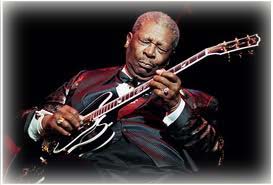« Sorensen "FX Blade" mandolin |
Main
| Buddy Wachter: Hungarian Dances on banjo »
 May 16, 2015 | On B.B. King May 16, 2015 | On B.B. King
The passing of blues legend B.B. King has us reminiscing this giant's legacy in music. Many great musicians reflect on his gift for communicating so much in so few notes. He played with such soul with the power of a pick stroke, the passionate squeeze of the fretboard, the nuance of slipping in and out of rhythm. It went beyond intellect and into the heart.
We pulled up an article from our archives that attempts to analyze what particular techniques went into this approach to playing.
From the November 2010 article "Dirty It Up."

B.B. King 1925-2015
If we are serious about performing well, we work a lot on the fundamentals of playing. Just as in sports, it's the fundamentals that allow us to perform the athletics and express our music more effectively, yet in the pursuit of effective execution, we can't forget that great technique is a means to an end, and not the end. It's often the bane of classical training, the musician who can play notes brilliantly, but not play the "music."
Listen to some classical musicians attempt jazz. They can sound stiff and unconvincing, despite playing all the notes cleanly and correctly. There's still something missing, and we suggest it's because of an unbending focus on execution rather than aesthetic. Not to condone sloppy playing, but once in a while a player needs to work from a solid skill base, and "dirty it up." Four elements to consider:
Rhythmic control. We learn to play in time. We have to do that, especially when playing in an ensemble setting. A good metronomic sense is crucial to cooperate with others in a group, and you need a good sense of rhythm to keep it consistent. The problem is in jazz (and bluegrass), you're missing the "swing." Notes aren't evenly divided into duples and triplets, there's a subconscious and grey area of timing that yields an aesthetic tension and energy, when subdivisions aren't clean. Things sound too "white."
Articulation. Good pick control is an inarguably important skill. Playing with a clear pick stroke is crucial to pushing tone and a strong fretting finger is the only way you can maximize sustain. That said, we still have tricks at our disposal, slides, hammer-ons, pull-offs, mutes, and harmonics. It's these more subtle ingredients that give our music character and individual identity. Pick and fret cleanly, but don't think every note has to be started by a pick. Don't be afraid to glissando into a note, or prior to its release.
Dynamics. Variations in volume are routinely overlooked by the best of players. We have to have more than two dynamics, loud and off. Playing quietly makes the louds louder. Fortissimo is great for statement and drama, but the ear tires quickly, and we need the contrast. Subtle changes in picking including grip, angle, and pick contact can also lend character to a passage. Silence can be a terrific weapon.
Phrase consistency. Thinking where our musical sentences start and stop is important, but we need to go the next step and build within these "story arcs" the sense of action. We start soft, build, climax, and get soft again. Introduction, tension, resolution. Tell a tale, communicate an aesthetic narrative within the string of notes, or that's all you have. A string of notes.
We don't want to undermine the importance of good technique. You really can't embrace the subtleties we mentioned without a strong physical command of your instrument. Scales and arpeggios are crucial to developing these abilities, and unintended sloppiness is not pleasant to listen to. Once you have achieved some of the fundamentals, embrace the next step.
Dirty it up.
Further:
It don't mean a thing, if it ain't...
Tremolo. Stirred, not shaken.
Keeping it honest: metronomes
Pick propulsion
Respect the Silence
Posted by Ted at May 16, 2015 5:36 AM

Disclaimer: In the 'Information Age' of the 21st Century,
any fool with a computer, a modem, and an idea can
become a self-professed 'expert." This site does not
come equipped with 'discernment.'
|



